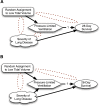Instrumental variable analyses. Exploiting natural randomness to understand causal mechanisms
- PMID: 23802827
- PMCID: PMC3960904
- DOI: 10.1513/AnnalsATS.201303-054FR
Instrumental variable analyses. Exploiting natural randomness to understand causal mechanisms
Abstract
Instrumental variable analysis is a technique commonly used in the social sciences to provide evidence that a treatment causes an outcome, as contrasted with evidence that a treatment is merely associated with differences in an outcome. To extract such strong evidence from observational data, instrumental variable analysis exploits situations where some degree of randomness affects how patients are selected for a treatment. An instrumental variable is a characteristic of the world that leads some people to be more likely to get the specific treatment we want to study but does not otherwise change those patients' outcomes. This seminar explains, in nonmathematical language, the logic behind instrumental variable analyses, including several examples. It also provides three key questions that readers of instrumental variable analyses should ask to evaluate the quality of the evidence. (1) Does the instrumental variable lead to meaningful differences in the treatment being tested? (2) Other than through the specific treatment being tested, is there any other way the instrumental variable could influence the outcome? (3) Does anything cause patients to both receive the instrumental variable and receive the outcome?
Figures





References
-
- Angrist JD, Evans WN. Children and their parents' labor supply: evidence from exogenous variation in family size. Am Econ Rev. 1998;88:450–477.
-
- Seok J, Warren HS, Cuenca AG, Mindrinos MN, Baker HV, Xu W, Richards DR, McDonald-Smith GP, Gao H, Hennessy L, et al. Inflammation and Host Response to Injury, Large Scale Collaborative Research Program. Genomic responses in mouse models poorly mimic human inflammatory diseases. Proc Natl Acad Sci USA. 2013;110:3507–3512. - PMC - PubMed
Publication types
MeSH terms
Grants and funding
LinkOut - more resources
Full Text Sources
Other Literature Sources

